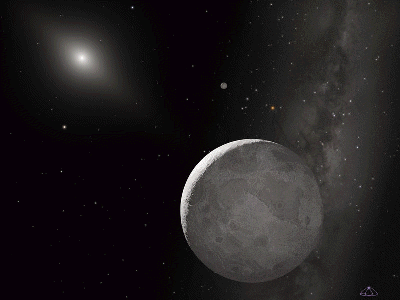Eris

Eris was discovered in 2003 and is the second largest of the known Dwarf Planets. It is accompanied by a moon called Dysnomia. Eris is named after the Greek goddess of discord, possibly because of the chaos its discovery went on to cause!
Eris takes almost 557 years to complete a full journey around the Sun. Like Pluto, but unlike the eight regular planets (Mercury, Venus, Earth, Mars, Jupiter, Saturn, Uranus and Neptune), its orbit is tilted and elliptical. The eight planets orbit on a level plane with each other, but Eris orbits above and below the other planets. The eight planets also orbit in fairly circular orbits, whereas Eris (and Pluto) can go from being great distances away from the Sun to being almost as close as Neptune is from the Sun. The diagram below shows how Eris' orbit compares with the orbits of the outer planets and Pluto. The diagram on the left in the image below shows the orbit as if we can see all of the planets from above so you can see how far Eris goes away from the Sun and how close it can get. The diagram on the right in the image below shows the planets as if we can see them from the side and shows how Eris orbits above and below the other planets and Pluto. This image shows where the objects would have been on 29th July 2005, which shows that Eris is about as far away as possible away from the Sun.

Eris didn't get its name until August 2006. Its discovery was announced in July 2005, when it became known as 2003 UB313 and nicknamed Xena. Images taken in October 2003 of a distant area in the Solar System were analysed by astronomers looking for Trans-Neptunian Objects, objects orbiting beyond the orbit of Neptune. Trans-Neptunian Objects that had already been discovered were Pluto, Quaror, Orcus and Sedna, very small round worlds orbiting many, many miles away from the Sun. During analysis of the different images, an object was spotted which slowly moved across the background of stars. Calculations revealed that the object was almost twice as far away from the Sun as Pluto, and measurements put it at about 2,326 km in diameter (1,445 miles). On discovery, it was thought to be larger than Pluto, but more recent measurements of Pluto have measured Pluto's diameter at 2,374 km (1,475 miles), meaning that Pluto is slightly. Due to its similarities to Pluto, 2003 UB313 became labelled as the tenth planet in the Solar System both by NASA and by the people who discovered it. However, not all astronomers were happy with the idea that the new object should be classified as a planet. Pluto's status as a planet had been debated for many years with many scientists feeling that it didn't fit in with the other eight planets, but had allowed it to remain as one because it didn't fit into any other category either! With the discovery of 2003 UB313 and the other Trans-Neptunian Objects, it was becoming apparent that a new category for these objects would have to be created. In August 2006, astronomers from all over the world met in the Czech Republic to discuss the definition of planet. They redefined what a planet is and, at the same time, created a new category of planet; the Dwarf Planet. As well as being smaller than regular planets, Dwarf Planets are also worlds that haven't "cleared the neighbourhood around their orbits". Their orbits cross other orbits and they orbit in "belts" with other objects. Ceres is the closest Dwarf Planet to the Sun, orbiting between Mars and Jupiter in the Asteroid Belt. It was recognised as an asteroid for most of its known existence (it too was known as a planet for about 50 years after being discovered in 1801 until becoming an asteroid) but was reclassified again after the creation of the Dwarf Planet category. Pluto was demoted from planet to Dwarf Planet and 2003 UB313 became the other object to be known as a Dwarf Planet. The International Astronomy Union also decided that it needed a more catchy name, and shortly after becoming a Dwarf Planet, it earned its name Eris, named after the Greek God of Discord quite possibly because of the trouble its discovery caused!
Very little else is known about Eris at the moment. Its orbit and size have been calculated, and a small moon is known to orbit it. The moon was discovered in September 2005, and is about 300-400km in diameter, estimated to take about 2 weeks to complete an orbit around Eris. Because Eris was nicknamed Xena, the new moon was nicknamed Gabrielle after the sidekick of Xena in the television programme, Xena: Warrior Princess! It officially became known as Dysnomia shortly after Eris received its name, being named after the Greek word for lawlessness. In Greek mythology, Dysnomia was the daughter of Eris. Also, the actress who played Xena in Xena: Warrior Princess, is named Lucy Lawless, her name resembling the Greek meaning of Dysnomia - lawlessness.
